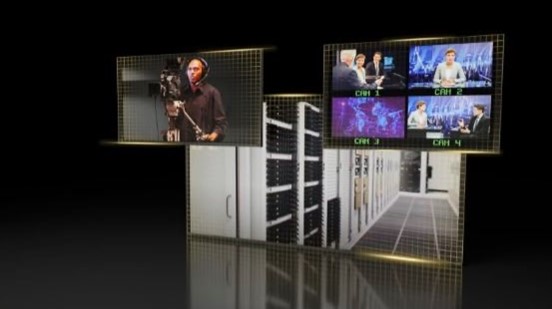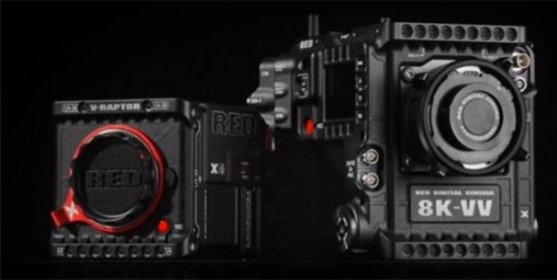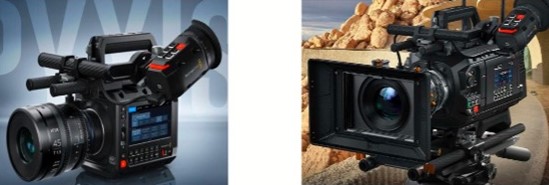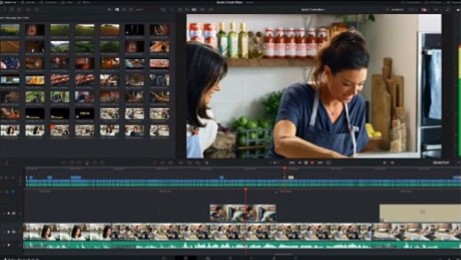“My empathy is creeping towards what I would describe… a contemptuous rage.” –Bella Baxter, Poor Things, Disney, 2023
For an organization, and industry, that is trying to define/redefine itself, NAB 2024 was packed with a lot of great products, services, and technology. It also had just enough touchy-feely of what the industry may look like tomorrow to keep you guessing.
For the time being, let’s focus on the industry in transition. Transition? Broadcast is such a minor portion of the industry today. People at the show make money doing film/show production/distribution and cable/pay-TV, as well as SVOD, AVOD, PVOD, FAST, social video, and a shrinking amount of broadcast. Exhibitors and some attendees told us the answers for the future, they just aren’t certain which are the right questions.
The first thing we noticed in checking the sessions and walking the halls is that contrary to a popular global donut chain (13,200 locations, 40 countries), the world doesn’t run on Dunkin’. We’d venture to say that the power tool that runs the industry’s hardware, software, and service is made by Nvidia and a few competitors—AMD, Intel, Samsung, Apple, and others. It’s true, and we focused our attention on AI where it makes the most sense for the industry now and in the near future—production and customer content selection—not on the AI that was going to do “everything,” including all your work for you, make you handsome/beautiful, and make you filthy rich. We’ll leave that to the AI techies.

Power driver—A lot of the NAB attendees probably didn’t realize it (and didn’t care), but the accelerated creation, production, and demand for today’s dynamite films and shows owes a lot to high-speed, high-performance GPUs from firms like Nvidia. The company has also been ultra-aggressive in making the wave of AI solutions available. (Source: Nvidia)
All of those content creation/production/distribution products, services, and tools are based around super-high-performance GPU technology. It’s the stuff industry folks need to push content creation to the max so they can make/deliver shows/movies that are more real than real. Those GPUs are so important that governments are throwing money at the companies to design/produce more—more powerful (and maybe a little cheaper) chips, tools, and technology to do… more.
In fact, if it weren’t for the GPUs and stuff like Unreal Engine (easily the most powerful and widely used real-time 3D tool), most of the people in the booths wouldn’t be able to brag about how they’ve incorporated the best AI technology in their products/services. Just don’t ask them how and why their AI-embedded solution is the best because a lot of times they have trouble spelling AI. Fortunately, there were those who understood that it’s all about capturing, storing, using data/information to do things faster, more consistently, and more reliably to make better content and deliver entertainment.
The rest right now is a cute acronym running wild.
When it comes to video capture at the show, two firms—Blackmagic Design and RED Digital Cinema—showed off some great advances this year.

Cinema)
Just before RED Digital unveiled its new V-Raptor [X] and V-Raptor XL [X] cameras, Nikon announced the acquisition completion of the company to expand more rapidly into the pro digital cinema camera market. Meanwhile, RED cameras have been the leading choice of filmmakers and cinematographers since the Red One was introduced back in 2005. The new large-format cinema cameras include the industry’s first global shutter. Designed for virtual and live production, users can also take advantage of the company’s advanced workflows with slo-mo, AI/ML augmentation, and live-to-headset functionalities. The new cameras keep RED on the leading edge of the content capture/workflow arena.

Blackmagic’s president, Dan May, told us a long time ago that his boss, Grant Perry, had a goal of becoming the world’s leading and largest professional camera producer, and they’re more than on track in that regard. As usual, the company unveiled a dizzying array of new products and cinema, broadcast camera upgrades this year, including the new low-cost Pyxis 6K up to the Ursa Cine 17K. The compact Pyxis 6K box design was designed for easy operation and setting changes, as well as high-capacity, high-speed dual CFexpress card slots wrapped up in a price that even an indie filmmaker can handle at $2,995.
Staffers only gave vague hints regarding the Cine 17K (available late this year), but the new Ursa Cine 12K created enough excitement with 16-stops of dynamic range, a full range of lens mounting, large sensor, expanded memory, and plenty of industry-standard connections.
The company went with a new proprietary high-speed memory module with the new camera, which, according to Blackmagic’s David Hoffman, eliminates media card problems and ensures a more reliable, faster data pipeline. The 8TB module lets you capture four hours of RAW in 12K or 20 hours in 4K, all wrapped up in a $14,995 package. You can add 8TB modules at only $1,500 each.
But, we feel it’s the company’s DaVinci Resolve where all the really creative work is done. It was purchased back in 2009, and since then, they have continually made it more useful and more powerful for everyone in the production arena.

The latest version, Resolve 19, includes the company’s new DaVinci Neural Engine AI tools and over 100 feature upgrades for the entire production team. Editors can work directly with transcribed audio to edit timeline clips, while colorists can quickly and easily produce rich film-like tones. VFX artists now have access to an expanded set of USD and multipoly rotoscoping tools.
Users have a tough time “outgrowing” Resolve 19 because there are now tools even for high-end digital film production and live broadcasting. In addition, it integrates seamlessly with the Blackmagic Cloud for smooth, professional production for live and digital content distribution.

We think Adobe is one of the few companies that has implemented AI intelligently for the content creation industry, and in the process, they thought through every step of the video content creation and production workflow—not to replace creatives but to give them more power, more flexibility, more freedom to do whatever they can envision.
Their new Firefly video uses the best-of-breed AI technology that has been thoroughly vetted before it has been released to production people. It doesn’t mean much to techies who simply cross their fingers and hope. Instead, it guarantees that what you produce doesn’t breach any copyright and can be used commercially. That’s embedded into all of their generative AI tools including text-to-video, scene extensions, and add/remove objects. Everything except when you’re using third-party plug-ins, which means… know your tool provider!
And, if you’re interested in using some of those generative AI products that have been released into the wild, they’ll support them.

If your production is transitioning from SDI (serial digital interface) to IP (Internet Protocol) workflow, Avid’s Stream IO supports everything from low-resolution proxy to UHD (ultra-high-definition). It also supports playlist creation, expanded on-screen display options, and added RAIDZ1 storage protection.
The company rolled out a number of new applications that will enable AI creative intelligence while keeping the human in the approach. They showed off all of the new features of Media Composer including Avid Ada, which will automate speech-to-text transcription, summarization, language translation, and recommendation engines. For audio postproduction, the company enriched Avid Pro Tools for dialogue, re-recording, ADR, and mixing. Audio editors tell us it really does provide the best-in-class immersive audio workflows, and we never question pros who have been doing audio for years.

Everything in the content industry touches and/or works in the cloud, so it’s only logical that AWS (Amazon Web Services) would be at NAB to show off all its content production, storage, delivery, and protection capabilities. The company not only works with and supports all of the industry leaders we’ve already mentioned, but they also provide some of the best, most complete content production, broadcast, live production, and delivery capabilities available.
At NAB, they showed off a cloud-based newsroom and how they’re helping leading streaming services deliver high-quality, high-resolution, low-latency content to the home. They also highlighted their global purpose-built storage, enrichment, and processing services. And, since everyone is pushing to make a profit in the industry, they also showed how their media supply and data science/analytics service can protect and monetize customer engagement and personalization across all the platforms and channels.
Sub versus dub
The global success of Netflix’s South Korea-produced Squid Game got a lot of social media attention as folks spoke out about the pros and cons of English subtitles or dubbing. With the short-term shutdown of content creation in the Americas, a different use of AI suddenly became popular for folks who needed to keep their libraries full of fresh, new, and different content—media versioning and localization. Historically, US content creators would add subtitles—the bottom inch—to films and show them in theaters and on home screens to folks in other countries. If it was a real tentpole like James Cameron’s Avatar, they’d go to the added time and expense to lip-synch the film in the local language. But for Avatar: The Way of Water, they used advanced AI versioning and localization technology.
When we caught up with Allan McLennan, 2G Digital Post’s president, on the show floor, he said the sub versus dub “discussion” first began when Netflix, Amazon, and Apple expanded their foreign language content, like Squid Game, a few years ago.
“User acceptance of dubbed projects has been the norm for years upon years in non-English-speaking countries,” McLennan noted. “In fact, an EU Commission survey found that 80% of the audiences preferred subtitles. That all changed when Bong Joon-ho’s Parasite swept the Oscars back in 2020. Suddenly, people were interested in the content rather than the audio delivery.
McLennan continued: “Because of the cost difference, we still do a tremendous amount of subtitle work, but now that people in the Americas and other English-speaking countries have discovered, there’s a rich, interesting range of content available in other languages. They’re voting with their seats in seats and streaming selection, and opting for the film/show to watch that is subtitles or a premium film dubbed in their language of choice. Now with the additional ability to accelerate a broader range of subtitling with faster turnaround with AI, along with initial human synthesized voice modulation that is all quality checked by expert linguists, it helps drive wider audiences, enabling us an industry to provide a full world of entertainment.”
In other words, the cloud delivers an answer for almost everyone in the content industry (including the consumer), whether you’re creating, producing, selling, advertising on/around, storing, or simply watching great visual entertainment.
Great, but when it comes to content creation, we think there’s still something reassuring, comforting about being able to reach over and pat the storage that contains all your work. For that, we checked out OWC’s newest. Larry O’Connor and his team had a nice array of new products for the guy/gal who’s shooting, doing post work or DIT (digital imaging tech), and for those who are responsible for keeping track of all of the digitally created work. They showed off a new Atlas Ecosystem that includes ultra-fast SD, CFexpress memory cards, card readers, and Innergize memory optimization software for end-to-end integrated camera storage. The new USB4 CFexpress card reader delivers transfer speeds up to 5,000 MB/sec to save time when you’re offloading data. The new ThunderBlade X8 is great for video editing, 3D rendering, and content creation, delivering up to 2,945 MB/sec speed and 16% more capacity when it’s used in RAID 4 and 5 configurations.
OWC also refreshed its all-flash shared-storage Jellyfish products with Nomad and Studio versions. The compact Nomad with up to 64TB of RAW capacity is something DITs, indie 3D/VFX studios, and on-the-go editing teams will want to look at. Their new Studio includes dual 10GbE ports that handle up to 14 simultaneous users and 3500 MB/sec throughput. The mobile unit provides up to 120TB of storage that you’ll (hopefully) need.
There were a lot more products/services on display for the 61,000 attendees to see and learn about, including information-packed sessions for folks from all corners of the content industry.
The sessions actually could have been the best part, because as Bella Baxter said in Poor Things,“It is the goal of all to improve, advance, progress, grow.”
Of course, there were also a number of what we felt were fantasy storylines floating around. We’ll touch on some of them next week.